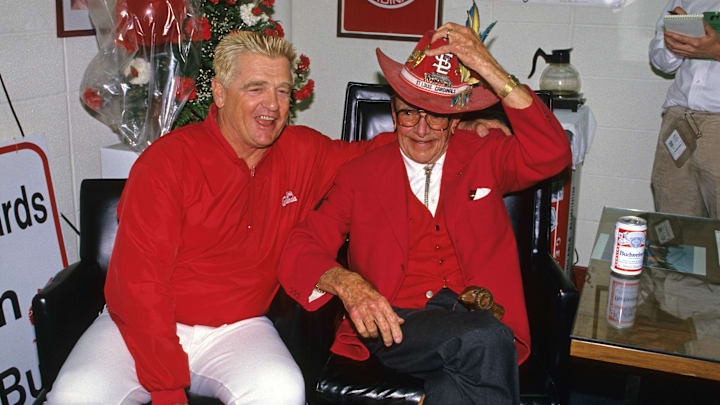On February 20th, 1953, beer baron and self-proclaimed "sportsman" August "Gussie" Busch II purchased the St. Louis Cardinals from Fred Saigh for just $3.75 million.
Prior to selling the Cardinals to Gussie Busch, Fred Saigh, who was facing serious debt and trouble with the law, was considering moving the team out of St. Louis. If he could find a wealthy enough buyer in the area, all the better. In fact, there were talks about moving the team to Milwaukee, another city with a massive beer presence in Pabst and Schlitz.
The St. Louis Cardinals were an attractive entity to Gussie. In Bitter Brew: The Rise and Fall of Anheuser-Busch and America's King of Beers, William Knoedelseder wrote that "Gussie liked everything he heard. With one move, he could deny the city of Milwaukee, home of Pabst and Schlitz, a professional baseball team, wrest the Cardinals' broadcasting rights away from Griesedieck Brothers, and turn Sportsman's Park, where the Cardinals played, into a giant outdoor tavern — thirty thousand Budweiser drinkers held captive for two or three hours at a time in the sweltering St. Louis heat."
Purchasing the Cardinals was also a sign of goodwill. Busch, a local at this point, purchasing the team showed his commitment to the city, and he would forever be known as "the man who saved the Cardinals for St. Louis." From this point on, the Cardinals, Anheuser-Busch, and St. Louis all became synonymous with one another.
The Cardinals were in the midst of a six-year postseason drought when Gussie purchased them, and the dry spell would continue for another 11 years before the club won the World Series in 1964. The clubs of the 1950s weren't without talent; Stan Musial, Red Schoendienst, Enos Slaughter, and Eddie Stanky were all familiar names, but the team couldn't escape the doldrums of the difficult National League.
Gussie Busch was not only a symbol of beer, but he also quickly became a figurehead for the St. Louis Cardinals and the city.
Immediately after purchasing the Cardinals, Gussie made it his mission to be a hands-on owner. According to Knoedelseder, "Three days after the stockholders meeting, he pulled into the Cardinals spring training camp in St. Petersburg, Florida, behind the wheel of his motorbus, trailed by a caravan of Cadillacs containing a retinue of cronies and company executives that, according to Post-Dispatch writer Jack Rise, 'looked like it had been recruited from a P.G. Wodehouse March on the Rhine.'"
He could be seen posing for pictures at the stadium with various players and awkwardly holding a baseball bat. Gussie went so far as to purchase a $300,000 railroad car for himself that would be hitched to the team train for road trips.
Another part of Gussie's plan to promote the Cardinals hinged on the inclusion of black players. After seeing the amount of white players on the team, Busch feared that black people in and around St. Louis would boycott both the team and his beer. He also took a moral issue with the lack of diversity on the roster. Therefore, Tom Alston was signed to be the first black player to ever play for the St. Louis Cardinals.
Initial success wasn't found after Gussie Busch's purchase of the franchise. However, the club experienced ample success from 1964 through the end of his family's ownership. From 1953 through 1995, the St. Louis Cardinals won three World Series, five National League pennants, and four division titles. (Divisions weren't established in Major League Baseball until the 1969 season.)
Gussie Busch's ownership of the Cardinals reminds us of a time when local ownership was vital to the sport of baseball.
Even before purchasing the St. Louis Cardinals, the Busch family was known as a true St. Louis family. They had already built one of the nation's largest breweries, and they employed large swaths of the city at any given time in history. Purchasing the Cardinals and promising to keep them in the city only further endeared St. Louisans to the Busch family.
When the Busch family sold the St. Louis Cardinals to Bill DeWitt Jr. and Stephen F. Brauer in 1995, local ownership was maintained. DeWitt, a St. Louis native, immediately continued the Busch family's desire to build a local team. He established Cardinals Care in 1997, he's built nearly two dozen baseball fields in and around St. Louis, and he's created networks of baseball leagues for kids in rural areas throughout Missouri and Illinois.
Bill DeWitt Jr. has been at the helm for two World Series titles, four National League pennants, and 12 division titles. However, the last decade of performance has been underwhelming outside of a brief postseason run in 2019.
Fans have also begun growing tired of Bill DeWitt Jr.'s dialogue surrounding baseball ownership. He said back in 2020 that owning a team "isn't very profitable," and he echoed those comments this offseason when he stated that there have been years where ownership has lost money despite the fact that the value of the team — which isn't liquid cash, of course — has risen exponentially since 1995.
If the DeWitts decide to sell, a sentiment that is popular amongst fans but not in the plans of the family, there are several local billionaires who could mirror the purchase of August "Gussie" Busch way back in 1953.
Gussie Busch and the Busch family were excellent owners of the St. Louis Cardinals for over four decades. Their purchase of the franchise in 1953 saved the team and kept them in St. Louis for decades to come.
